Cockpit AI Agent: Autonomous scenario creation becomes the first step to personalize cockpits
In AI Foundation Models’ Impacts on Vehicle Intelligent Design and Development Research Report, 2024, ResearchInChina mentioned that the core of an AI Agent uses a large language model (LLM) as its core computing engine (LLM OS). In the AI service framework, the LLM acts as AI core and the Agent acts as AI APP.? With the help of reasoning and generation capabilities of? AI foundation model, the Agent can create more cockpit scenarios, while further improving current multimodal interaction, voice processing and other technologies in the cockpit.
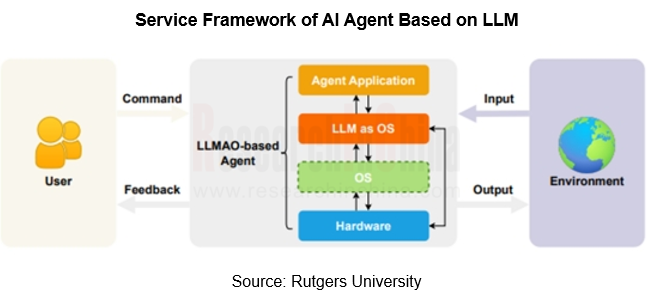
Compared with the traditional OS, AI OS is programmed in natural language, which is more suitable for human operation and convenient for customization and personalized human-computer interaction. The Agent responds to user prompts or instructions in natural language, and can perform a lot of tasks according to its interaction with physical or digital environment.
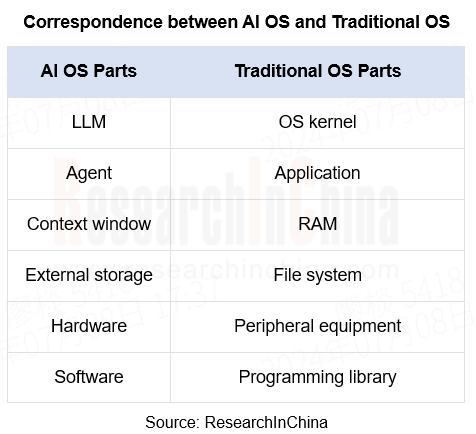
Foundation models spawn Agent customized scenarios
Since AI foundation models were installed in cars, they have been widely used in multimodal interaction scenarios. OEMs have started from voice assistants to further improve? intelligent processing of user commands:
Before foundation models got on cars, the wake-up rate and effective instructions of voice assistants in cockpits are at a low level;
After foundation models were available in cars, not only has voice recognition become more intelligent, but the application of expression monitoring and gesture control have also been improved, with effective commands and daily active rates increasing significantly.
AI foundation models further enhance the user experience of smart cockpits through strong context processing and reasoning capabilities. Please refer to the following dialogue:
(Mobility scenario)
--**Tongxue! (the name of a voice assistant)
-I am here!
-There seems to be a prairie ahead. Please take a picture for me!
-Wait a moment, and I will capture the beautiful scenariory of the prairie for you. I'll let you know when the photo is taken. Is there anything else I can help you with?
-Send it to Moments immediately. I want my friends to have a look at this beautiful scenariory.
-Ok, according to your authorized account, please choose the material and filter style.
-Just this one, with a caption.
-Ok, three captions have been generated for you. Which one do you like?
-Just this one.
(You enter the office and receive a phone call)
-There is a phone call from a customer, and I have transferred it to the IVI for you.? Would you like to answer it?
-Yes, and turn on the office mode.
-Ok, I will generate an avatar of the customer for you and start the conversation. Do you have any questions or things to discuss? I will record the conversation and provide you with the minutes of the meeting after it is over.
(The avatar is generated)
-Now you can start the conversation.
The above scenarios will not be materialized in the cockpit until 2024 when foundation models are installed on vehicles by some OEMs.
For example, IM L6 has built Carlog and City Drive scenarios to enable the AI foundation models to proactively recommend food and attractions and allow users to post them on social media:
Carlog: Actively perceive the scenario during driving through AI vision foundation model, mobilize four cameras to take photos, automatically save and edit them, and support one-click share in Moments.
City Drive: Cooperate with Volcengine to model nearby food, scenic spots and landmarks in real time in the digital screen, and push them according to users' habits and preferences.

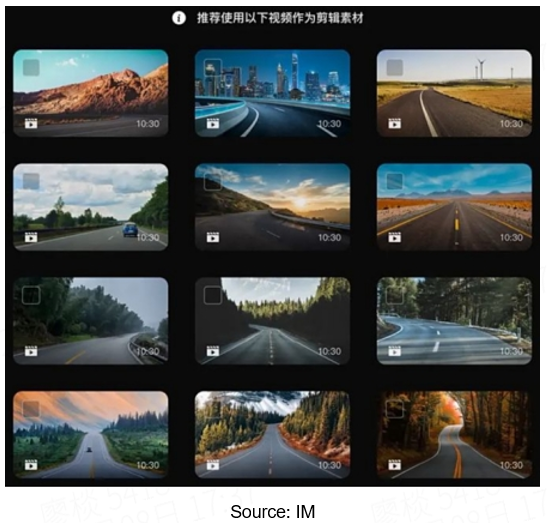
The applicability of foundation models in various scenarios has stimulated users' demand for intelligent agents that can uniformly manage cockpit functions. In 2024, OEMs such as NIO, Li Auto, and Hozon successively launched Agent frameworks, using voice assistants as the starting point to manage functions and applications in cockpits.
Agent service frameworks can not only manage cockpit functions in a unified way, but also provide more abundant scenario modes according to customers' needs and preferences, especially supporting customized scenarios for users, which accelerates the advent of the cockpit personalization era.

For example, NIO’s NOMI GPT allows users to set an AI scenario with just one sentence:
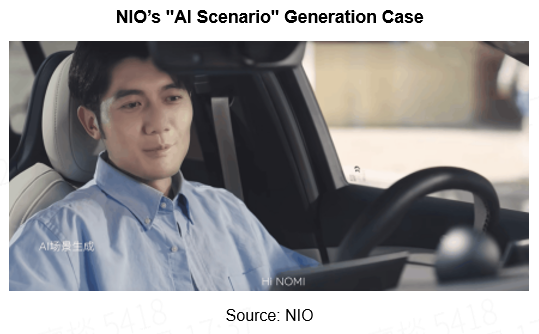
Core competence of cockpit Agents
AI Agents in the era of foundation models are based on LLMs, whose powerful reasoning expands the applicable scenarios of AI Agents that can improve the thinking capability of foundation models through feedback obtained during operation. In the cockpit, the Agent capability paradigm can be roughly divided into "Understanding" + "Planning" + "Tool Use" + "Reflection".
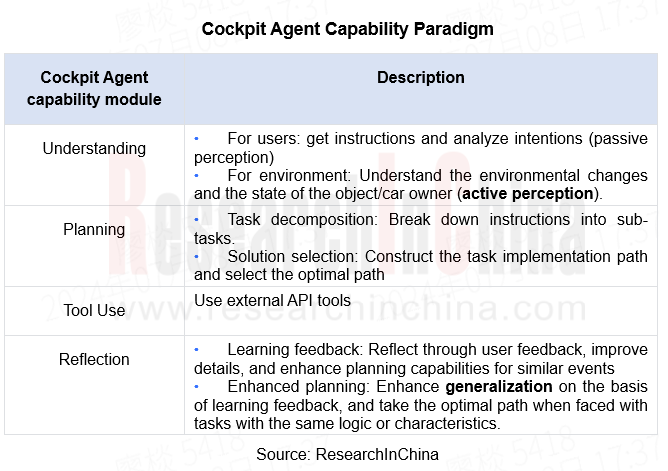
When Agents first get on cars, cognitive and planning abilities are more important. The understanding of task goals and the choice of implementation paths directly determine the accuracy of performance results, which in turn affect the scenario utilization rate of Agents.
For example, in Xiaomi's voice interaction process, semantic understanding is the difficulty of the entire automotive voice processing process. XiaoAi handles semantic parsing through a semantic parsing model.
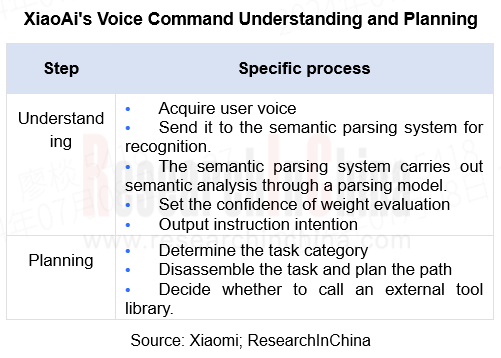
After the mass production of Agents, the personalized cockpits that support users to customize scenario modes become the highlight, and Reflection becomes the most important core competence at this stage, so it is necessary to build an Agentic Workflow that is constantly learning and optimizing.
For example, Lixiang Tongxue offered by Li Auto supports the creation of one-sentence scenarios. It is backed by Mind GPT's built-in memory network and online reinforcement learning capabilities. Mind GPT can remember personalized preferences and habits based on historical conversations. When similar scenarios recur, it can automatically set scenario parameters through historical data to fit the user's original intentions.

At the AI OS architecture setting level, we take SAIC Z-One as an example:
Z-One accesses the LLM kernel (LLM OS) at the kernel layer, which controls the interfaces of AI OS SDK and ASF with the original microkernel respectively, in which AI OS SDK receives the scheduling of the LLM to promote the Agent service framework of the application layer. The Z-One AI OS architecture highly integrates AI with CPU. Through SOA atomic services, AI is then connected to the vehicle's sensors, actuators and controllers. This architecture, based on a terminal-cloud foundation model, can enhance the computing power of the terminal-side foundation model and reduce operational latency.
Application Difficulty of Cockpit AI Agents
Agents connect to users and execute commands. In the application process, in addition to the technical difficulties of putting foundation models on cars, they also face scenario difficulties. In the process of command reception-semantic analysis-intention reasoning-task execution, the accuracy of the performance results and the delay in human-computer interaction directly affect the user's riding experience.
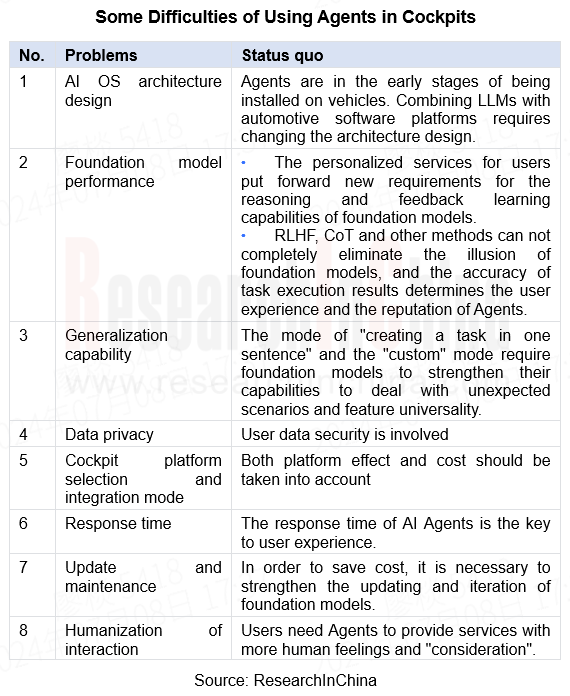
Humanization of interaction
For example, in the "emotional consultant" scenario, Agents should resonate emotionally with car owners and perform anthropomorphism. Generally, there are three forms of anthropomorphism of AI Agents: physical anthropomorphism, personality anthropomorphism, and emotional anthropomorphism.
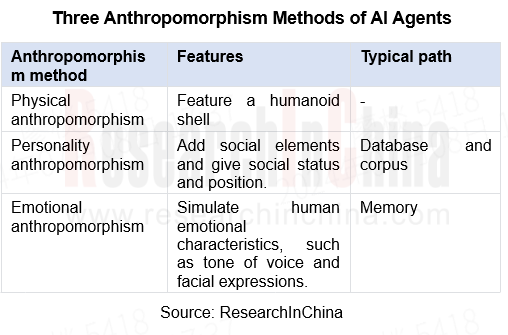
NIO's NOMI GPT uses "personality anthropomorphism" and "emotional anthropomorphism":
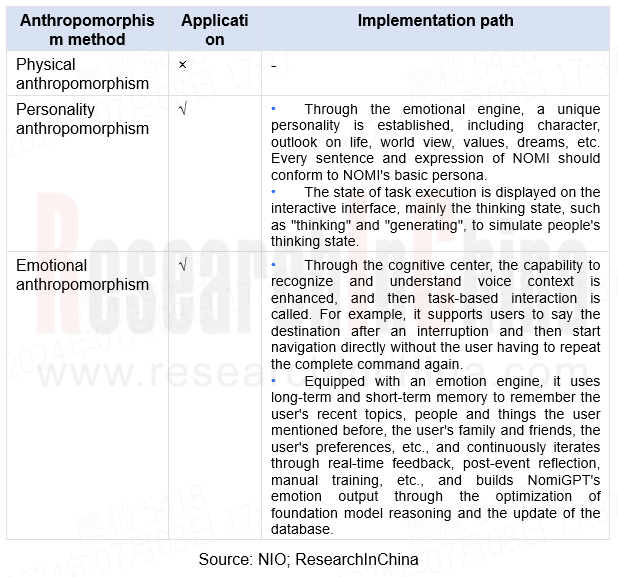
Foundation model performance
In the "encyclopedia question and answer" scenario, Agents may be unable to answer the user's questions, especially open questions, accurately because of LLM illusion after semantic analysis, database search, answer generation and the like.
Current solutions include advanced prompting, RAG+knowledge graph, ReAct, CoT/ToT, etc., which cannot completely eliminate “LLM illusion”. In the cockpit, external databases, RAG, self-consistency and other methods are more often used to reduce the frequency of “LLM illusion”.
Some foundation model manufacturers have improved the above solutions. For example, Meta has proposed to reduce “LLM illusion” through Chain-of-Verification (CoVe). This method breaks down fact-checking into more detailed sub-questions to improve response accuracy and is consistent with the human-driven fact-checking process. It can effectively improve the FACTSCORE indicator in long-form generation tasks.
CoVe includes four steps: query, plan verification, execute verification and? final verified response.
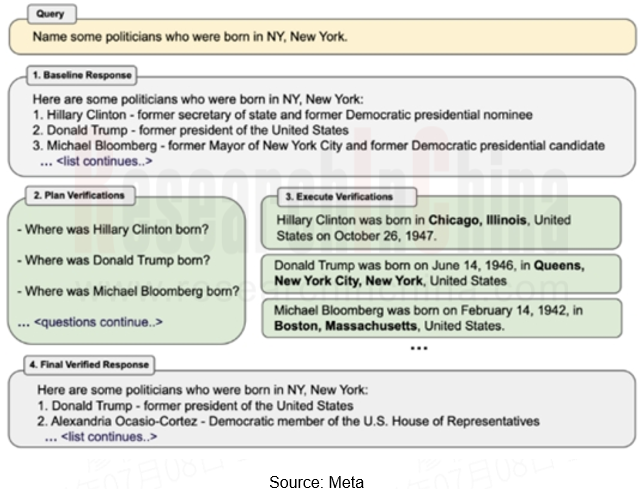
Autonomous Driving Domain Controller and Central Computing Unit (CCU) Industry Report, 2025
Research on Autonomous Driving Domain Controllers: Monthly Penetration Rate Exceeded 30% for the First Time, and 700T+ Ultrahigh-compute Domain Controller Products Are Rapidly Installed in Vehicles
L...
China Automotive Lighting and Ambient Lighting System Research Report, 2025
Automotive Lighting System Research: In 2025H1, Autonomous Driving System (ADS) Marker Lamps Saw an 11-Fold Year-on-Year Growth and the Installation Rate of Automotive LED Lighting Approached 90...
Ecological Domain and Automotive Hardware Expansion Research Report, 2025
ResearchInChina has released the Ecological Domain and Automotive Hardware Expansion Research Report, 2025, which delves into the application of various automotive extended hardware, supplier ecologic...
Automotive Seating Innovation Technology Trend Research Report, 2025
Automotive Seating Research: With Popularization of Comfort Functions, How to Properly "Stack Functions" for Seating?
This report studies the status quo of seating technologies and functions in aspe...
Research Report on Chinese Suppliers’ Overseas Layout of Intelligent Driving, 2025
Research on Overseas Layout of Intelligent Driving: There Are Multiple Challenges in Overseas Layout, and Light-Asset Cooperation with Foreign Suppliers Emerges as the Optimal Solution at Present
20...
High-Voltage Power Supply in New Energy Vehicle (BMS, BDU, Relay, Integrated Battery Box) Research Report, 2025
The high-voltage power supply system is a core component of new energy vehicles. The battery pack serves as the central energy source, with the capacity of power battery affecting the vehicle's range,...
Automotive Radio Frequency System-on-Chip (RF SoC) and Module Research Report, 2025
Automotive RF SoC Research: The Pace of Introducing "Nerve Endings" such as UWB, NTN Satellite Communication, NearLink, and WIFI into Intelligent Vehicles Quickens
RF SoC (Radio Frequency Syst...
Automotive Power Management ICs and Signal Chain Chips Industry Research Report, 2025
Analog chips are used to process continuous analog signals from the natural world, such as light, sound, electricity/magnetism, position/speed/acceleration, and temperature. They are mainly composed o...
Global and China Electronic Rearview Mirror Industry Report, 2025
Based on the installation location, electronic rearview mirrors can be divided into electronic interior rearview mirrors (i.e., streaming media rearview mirrors) and electronic exterior rearview mirro...
Intelligent Cockpit Tier 1 Supplier Research Report, 2025 (Chinese Companies)
Intelligent Cockpit Tier1 Suppliers Research: Emerging AI Cockpit Products Fuel Layout of Full-Scenario Cockpit Ecosystem
This report mainly analyzes the current layout, innovative products, and deve...
Next-generation Central and Zonal Communication Network Topology and Chip Industry Research Report, 2025
The automotive E/E architecture is evolving towards a "central computing + zonal control" architecture, where the central computing platform is responsible for high-computing-power tasks, and zonal co...
Vehicle-road-cloud Integration and C-V2X Industry Research Report, 2025
Vehicle-side C-V2X Application Scenarios: Transition from R16 to R17, Providing a Communication Base for High-level Autonomous Driving, with the C-V2X On-board Explosion Period Approaching
In 2024, t...
Intelligent Cockpit Patent Analysis Report, 2025
Patent Trend: Three Major Directions of Intelligent Cockpits in 2025
This report explores the development trends of cutting-edge intelligent cockpits from the perspective of patents. The research sco...
Smart Car Information Security (Cybersecurity and Data Security) Research Report, 2025
Research on Automotive Information Security: AI Fusion Intelligent Protection and Ecological Collaboration Ensure Cybersecurity and Data Security
At present, what are the security risks faced by inte...
New Energy Vehicle 800-1000V High-Voltage Architecture and Supply Chain Research Report, 2025
Research on 800-1000V Architecture: to be installed in over 7 million vehicles in 2030, marking the arrival of the era of full-domain high voltage and megawatt supercharging.
In 2025, the 800-1000V h...
Foreign Tier 1 ADAS Suppliers Industry Research Report 2025
Research on Overseas Tier 1 ADAS Suppliers: Three Paths for Foreign Enterprises to Transfer to NOA
Foreign Tier 1 ADAS suppliers are obviously lagging behind in the field of NOA.
In 2024, Aptiv (2.6...
VLA Large Model Applications in Automotive and Robotics Research Report, 2025
ResearchInChina releases "VLA Large Model Applications in Automotive and Robotics Research Report, 2025": The report summarizes and analyzes the technical origin, development stages, application cases...
OEMs’ Next-generation In-vehicle Infotainment (IVI) System Trends Report, 2025
ResearchInChina releases the "OEMs’ Next-generation In-vehicle Infotainment (IVI) System Trends Report, 2025", which sorts out iterative development context of mainstream automakers in terms of infota...